DSP vs SSP
What do these two abbreviations even mean and how are they connected?
Stay tuned to find out.
Basic Advertising Logic
So in order for advertising to work, we need two things
- a product the owning company wants to advertise
- a space where this product can be advertised to other people
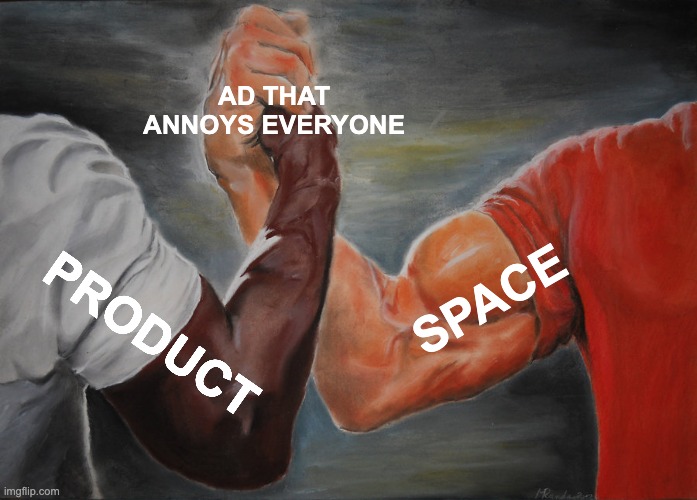
Okay, simple enough.
What do I mean by a product?
A product can basically be anything. Some examples being: CocaCola, the new HotWheels toy race car, Super Mario’s new game or a new social app called InstaFaceGramBook… You name it…
The companies behind these products are in advertising jargon usually called brands or advertisers.
What do I mean by a space? You’re probably thinking about… mobile ads… Well, I sure was, but there are also other spaces where advertising can appear on; city billboards, radio stations, newspapers, T-Shirts, even movies.
We live in a world where we don’t even notice something is being advertised as it’s already embedded into our lives to such extent that we automatically ignore it. For example while driving on the highway, most of the time you don’t even notice the billboard on the nearby field. Well, unless you’re bored to death so that even the clouds seem interesting.

Alrighty then, so now we have a product and we have a space.
The owner of the advertising space is called a publisher. The publisher’s space is also called ad inventory. Mobile games are usually publishers, since they are advertising other products. They do this to get some revenue, since an advertiser pays the publisher to advertise. Some games also want to be advertised in other games, websites, videos…, this method is called user acquisition and is very common during a launch of a newly created game.
Someone that advertises a product is called an advertiser. Advertiser is usually a third party agency also known as an ad provider (from publisher’s point of view), but it can also be the company that owns the advertised product; the term for latter is called a direct deal, since the product company and the publisher make a deal without the middle man. Direct deal example can be that Outfit7 has a deal with LEGO and in My Talking Tom there are bunch of rewarded videos for Lego Technic toys.

Side note: from the upper image it’s not certain whether TikTok and Voodoo are having a direct deal or TikTok is being advertised to Voodoo’s Helix Jump by a third party agency.
DSP and SSP
The direct deals are not that common meaning the middle man is usually present. Though the middle man is not a bad guy in this story, on the contrary, he’s quite helpful since he ensures publishers always have enough products to advertise and advertises have enough space to advertise their products on.
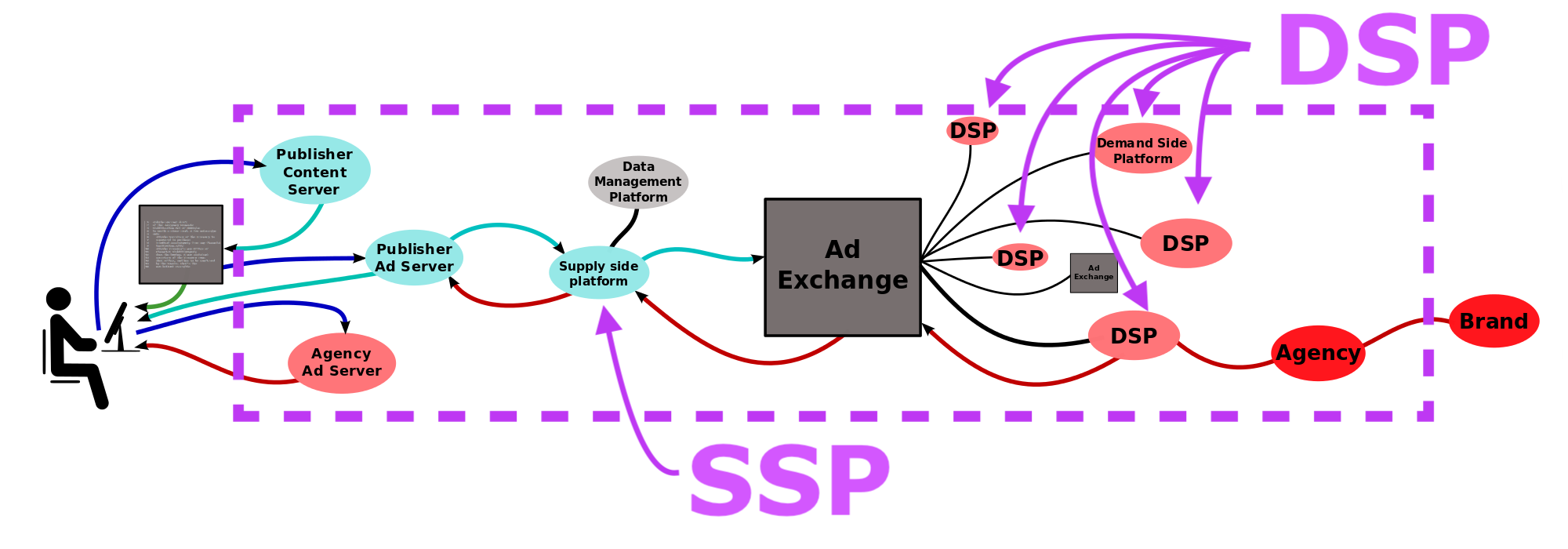
The middle guy I’m referring to is the pink rectangle in the upper picture.
As you can see, the upper picture also includes DSP and SSP. So what are they?
Well, they stand for
- Demand Side Platform
- Supply Side Platform
and as the names suggest, one is responsible for demand (brand product) and the other for supply (publisher space).
DSP
So let’s talk a bit about the Demand Side Platform aka DSP.
Demand Side Platform is essentially a software system that allows brands to buy publisher’s advertising space
through a unified interface. Brands don’t need to ask each publisher directly, instead they can bid on several
publisher spaces at once since multiple ad exchanges are wired into a single DSP.
These software systems are also called dashboards.
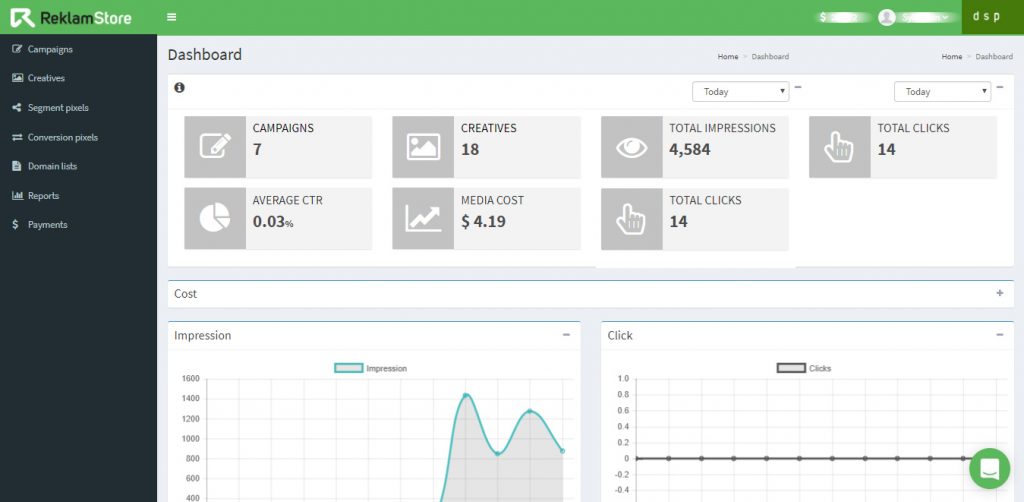
Through these systems each brand/advertiser can monitor and setup the configurations for each ad inventory for the ads they offer. Configuration like:
- CPM — cost per mile (1000 impressions)
- CCP — cost per click
- CPI — cost per impression
The DSP also offers brands/advertisers:
- ad performance monitoring
- real-time ad bidding:
- of a specific ad inventory — rewarded videos in Clash of Clans mobile game
- at a specific time — tomorrow morning at 6:51:44
- for a specific user — Max from California
Note that this all happens automatically; bidding is actually performed on a set of upper categories, and it can be defined per one or several categories also known as segments.
For example; a brand wants to buy ad inventory in California only on Banners in a specific time frame - Monday and Tuesday — this can be one setup and DSP offers many of these setups)
So how does it actually work? Well, essentially it’s like this:
- Advertiser uploads ad creatives to a Demand Side Platform and selects the segment he wishes to target with them.
- Publishers, on the other hand, makes their ad space (ad inventory) available for advertisers to bid on, through ad exchanges and SSPs (Supply Side Platforms) which eventually comes to the Demand Side Platform where the advertiser can actually place a bid.
- The platforms from publisher’s side (SSP, Ad exchanges, …) offer the Demand Side Platform impressions for the current ad inventory criteria (time, country, user, app, ad type, …) and the DSP then makes the decision to buy or skip the impression, based on advertiser’s specified segments and remaining budgets.
- The offered impression is a bidding that happens in a fraction of a second between many advertisers who compete with one another who’ll pay the most.
- In case the impression seems tempting enough for the given criteria, the Demand Side Platform places the highest bid and the advertiser gets the impression by outbidding the competition.
- By buying the impression, the advertiser’s ad creative is shown in the publisher’s inventory (~20sec of banner, 1 rewarded video or 1 interstitial, …)
Demand Side Platform also manages advertiser’s budget and based on it, the DSP decides easier whether an impression in a given time is actually worth buying based on advertiser’s budget and impression criteria.
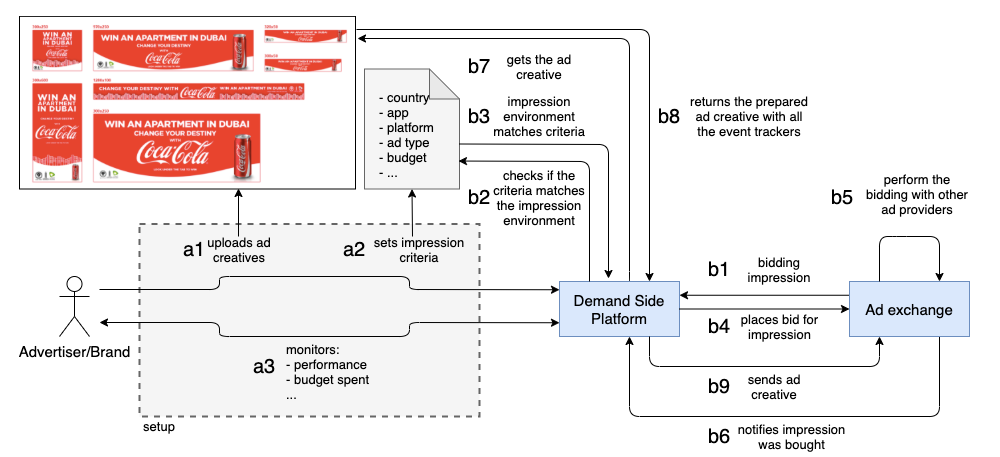
SSP
While DSP manages demand, or rather advertiser’s side of the equation, the SSP aka Supply Side Platform manages supply, or rather publisher’s side.
Like Demand Side Platform aids the advertiser’s side, the Supply Side Platform helps publisher’s side to specify what kind of ad inventory he has and how much he’s willing to sell it for to advertisers, through a unified interface.
The “how much he’s willing to sell it for” is also known as floor price, which is the minimum amount the publisher is willing to sell his inventory for. This can be used to have only high paying advertisers participating in the bidding process and to get rid of cheap ads, which are usually not as good, in terms of performance and ad creative quality, as the higher tier ones.
SSP also provides the publisher an option to sell the inventory, not only to one advertiser, but to several advertisers who bid for the inventory. The higher they bid, the more the impression is worth and the more the publisher earns.
The whole process goes like so:
- The publisher specifies the parameters for each ad inventory:
- application
- ad type
- platform
- 13+ vs non-13+ (kids vs non-kids)
each combination of these parameters is one item in the SSP dashboard also known as a placement for which he gets a unique ID from the SSP. It’s essentially a specification of the ad inventory so the advertiser knows what he’s bidding on.
For example: [ Fruit Ninja | Interstitial | Android | 13+ ] is one placement
Optionally the publisher can also set: - floor price
- category of desired ads (sports, games, media, porn, gambling) - for child friendly content the contract between SSP and the publisher
contains an agreement that there shall be no non-kid friendly content in ads (porn, gambling, adult stuff, …)
for each individual placement.
- The publisher makes an SDK (Software Development Kit - a package of code for the system to work) integration into his applications.
- The publisher starts doing HTTP requests (you know, the “CALL www.insert-SSP-name.com”) with the information for the each impression he’s offering:
www.insert-SSP-name.com/impression?placementID=a124farqfq2&country=Turkmenistan&time=112312424124429
(For the sake of the example, some stuff was added which a typical ad request doesn’t contain - information like time and country the SSP gets from the HTTP request meta data or headers) - SSP appends the placement parameters (the ones from point 1) for the placementID to the impression.
- SSP forwards the impression to an Ad Exchange which then forwards to DSPs that bid on it.
Note: There isn't just an Ad Exchange and DSPs on the other side, there are also Ad Networks, Direct Advertisers (direct deals - no bidding necessary), Agencies,... - SSP receives the winning bid from an Ad Exchange along with the ad creative with all event (impression, click) trackers.
Note: There are also times that no one bids on the impression which is marked as no fill. In this case the publisher normally doesn't show the interstitial or retains the previous banner (since banners are on-screen all the time). - The publisher shows the ad creative of the advertiser that won the bidding.
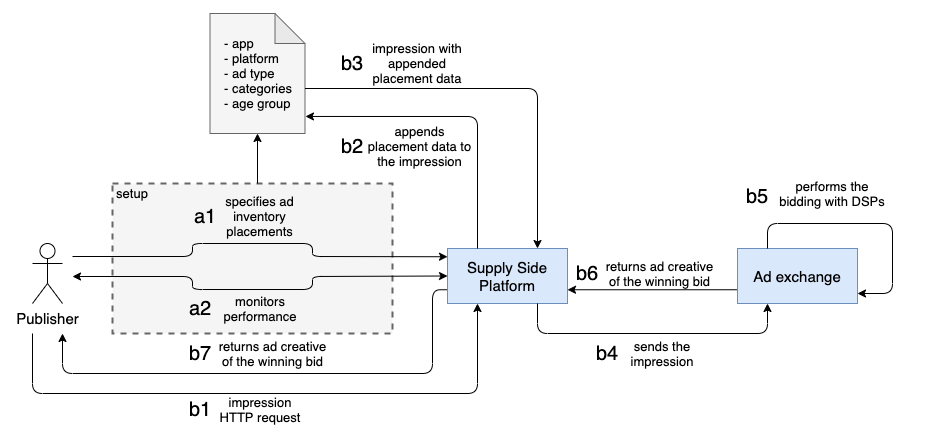
Conclusion
Demand Side Platform and Supply Side Platform are system that aid demand side (advertisers) and supply side (publishers). They take care of automatic bidding per advertiser’s or publisher’s preferences and provide performance monitoring for each. All of this is achieved through one unified interface.
DSP and SSP greatly simplified and automated providing ad inventory to several advertisers and bidding on ad inventory of several publishers, which increases the publisher’s revenue earning and optimises advertiser’s budget spending.





